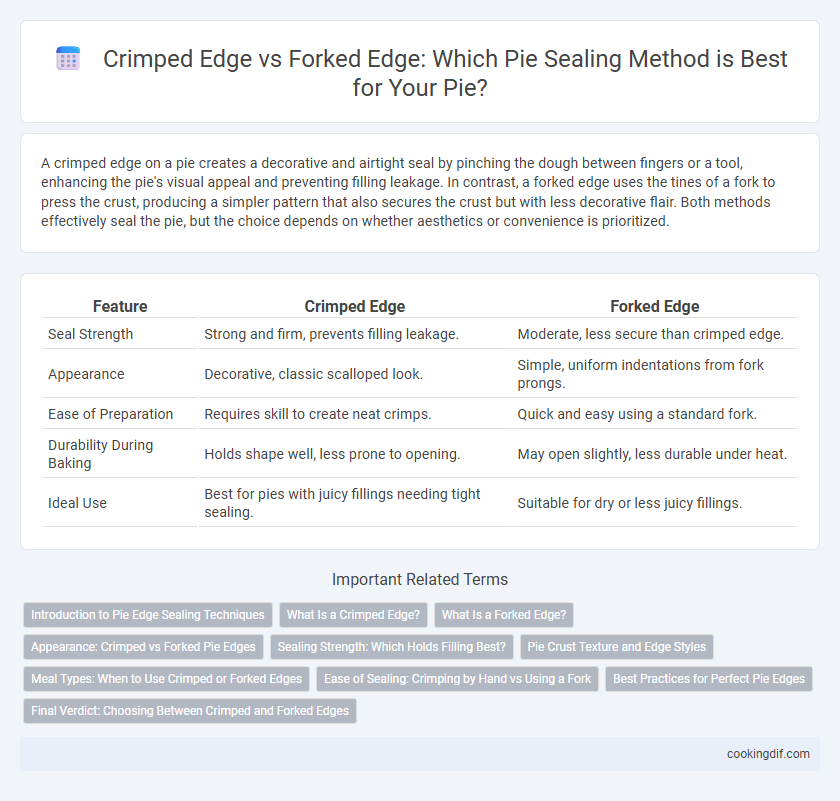A crimped edge on a pie creates a decorative and airtight seal by pinching the dough between fingers or a tool, enhancing the pie's visual appeal and preventing filling leakage. In contrast, a forked edge uses the tines of a fork to press the crust, producing a simpler pattern that also secures the crust but with less decorative flair. Both methods effectively seal the pie, but the choice depends on whether aesthetics or convenience is prioritized.
Table of Comparison
| Feature | Crimped Edge | Forked Edge |
|---|---|---|
| Seal Strength | Strong and firm, prevents filling leakage. | Moderate, less secure than crimped edge. |
| Appearance | Decorative, classic scalloped look. | Simple, uniform indentations from fork prongs. |
| Ease of Preparation | Requires skill to create neat crimps. | Quick and easy using a standard fork. |
| Durability During Baking | Holds shape well, less prone to opening. | May open slightly, less durable under heat. |
| Ideal Use | Best for pies with juicy fillings needing tight sealing. | Suitable for dry or less juicy fillings. |
Introduction to Pie Edge Sealing Techniques
Crimped edges and forked edges represent two distinct pie sealing techniques that enhance both appearance and structural integrity. Crimped edges involve pinching the dough between fingers or a tool to create a decorative, ridged border, which provides a strong seal preventing filling leakage. Forked edges use the tines of a fork to press and flatten the dough, forming a consistent pattern that secures the crust with less texture but equally effective sealing.
What Is a Crimped Edge?
A crimped edge on a pie is created by pinching the dough between your thumb and forefinger to form a decorative, sealed border that prevents filling leakage during baking. This technique enhances the pie's structural integrity and adds an artisanal touch, distinguishing it from forked edge seals, which utilize pressed fork tines for simpler closure. Crimped edges are favored for their aesthetic appeal and effective sealing properties, especially in fruit pies with juicy fillings.
What Is a Forked Edge?
A forked edge in pie sealing is created by pressing the tines of a fork gently along the edge of the pie crust, producing a series of small, evenly spaced indentations. This technique not only secures the top and bottom crusts together but also adds a decorative, rustic finish that enhances the overall appearance of the pie. Unlike a crimped edge, which involves pinching the dough between fingers or using a tool to create a wave pattern, the forked edge offers a quicker, more uniform seal ideal for both sweet and savory pies.
Appearance: Crimped vs Forked Pie Edges
Crimped pie edges create a uniform, decorative pattern that enhances the visual appeal with a classic, polished look. Forked edges offer a rustic, simple finish with parallel indentations that highlight a handmade, artisanal style. The choice between crimped and forked edges directly influences the pie's overall presentation, reflecting either elegance or casual charm.
Sealing Strength: Which Holds Filling Best?
Crimped edges create a tight, interlocked seal by folding and pinching the dough, providing superior sealing strength that prevents filling leakage during baking. Forked edges rely on tines pressing into the dough, offering less robust sealing which can allow juices to escape. For pies with wet or runny fillings, crimped edges are generally more effective in maintaining structural integrity and preserving the filling inside.
Pie Crust Texture and Edge Styles
Crimped edges create a tightly sealed pie crust that promotes even baking and a flaky, tender texture by trapping steam inside. Forked edges, while simpler to make, result in a more rustic appearance with less uniform sealing, which can cause edges to be slightly tougher and less crisp. Choosing between crimped and forked edges affects both the aesthetic and the texture of the pie crust, with crimping favored for professional, delicate crusts and forked edges preferred for casual, homemade pies.
Meal Types: When to Use Crimped or Forked Edges
Crimped edges provide a tight seal ideal for fruit pies and other juicy fillings, preventing leaks during baking. Forked edges work best for savory pies and pot pies, offering a rustic appearance while maintaining a secure closure. Selecting the appropriate edge type depends on the pie's moisture content and desired presentation.
Ease of Sealing: Crimping by Hand vs Using a Fork
Crimping by hand offers precise control over the pie edge, allowing for a tight seal that prevents filling leakage during baking and creates an attractive, traditional look. Using a fork to seal pie edges simplifies the process, ensuring quick and uniform pressure along the crust but may result in a less airtight seal compared to hand crimping. Overall, hand crimping demands more skill and time but provides superior sealing effectiveness, while fork sealing prioritizes speed and ease over optimal sealing performance.
Best Practices for Perfect Pie Edges
Crimped edges provide a tight seal that helps retain pie filling while creating a decorative finish, ideal for fruit pies prone to bubbling over. Forked edges offer a quicker technique for sealing with pressure points that prevent crust shrinkage, making them suitable for rustic or savory pies. Best practices recommend chilling the dough before sealing and using consistent pressure regardless of edge style to ensure the crust remains intact during baking.
Final Verdict: Choosing Between Crimped and Forked Edges
Crimped edges provide a traditional, decorative seal that ensures a firm closure while enhancing the pie's aesthetic appeal, making them ideal for fruit pies prone to juicy fillings. Forked edges offer a simpler and quicker method, creating consistent pressure points that secure the crust but may lack the intricate look of crimping. The final verdict depends on whether visual presentation or ease and speed are prioritized, with crimped edges favored for artisanal pies and forked edges suited for practical, everyday baking.
Crimped edge vs forked edge for pie sealing Infographic

 cookingdif.com
cookingdif.com